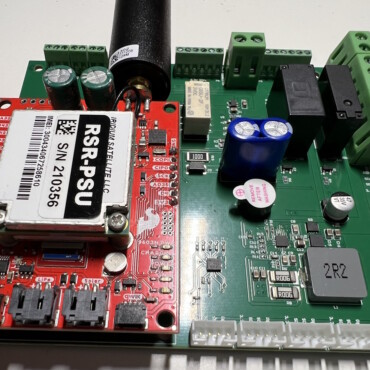While the mechanical design of our vessels garners most of the attention, the true powerhouse of our technology is the electrical system and supporting software. As far as we know, our boats are the most power-efficient USVs in the world, utilizing only 0.125 Watts for standard operations. In other words, using 1/800th the power of an old incandescent lightbulb, the vessel relays navigational information and data from over a dozen sensors hourly by satellite, stands by to receive course changes, and manages all operations for crossing an open ocean.
We have designed the electrical system from the ground up for extreme efficiency, functionality, and reliability. Even the wind vane and anemometer were designed in-house, as off-the-shelf versions didn’t meet our needs. Our servos lock and turn off when desired position is reached and various systems enter hibernation when not in use..
While our boats are frugal with power, there is plenty available with our 20 watt solar panel and lithium ion battery. In fact, in typical summer conditions, the boat is generating 20-40 times more electricity than required for sailing operations. This extra power is available for using the propulsion motor in Hybrid Voyager, or for more advanced onboard AI processing in future developments. It also means that in winter conditions, or no-light conditions (such as Arctic winter locked in the ice), the boats can continue to operate..
The system integrates with our various sensor packages through 10 I2C terminals, along with multiple analog and digital inputs. The heart of the electrical system is encased in a waterproof housing and is turned on and off using an external magnet. Basic sensors for navigation are included with the boat including GPS, magnetometer/gyro/accelerometer, battery voltage sensor, and other basic system health sensors.
 We offer a variety of sensor packages and individual sensors that can be purchased when ordering the boat. These sensors are installed at our facility and are ready to operate out of the box. Please note; Wind Wanderer does not have the ability to transmit sensor data, and an onboard data logging package is available instead. This means the data can be downloaded when the vessel is retrieved, and not in real-time.
We offer a variety of sensor packages and individual sensors that can be purchased when ordering the boat. These sensors are installed at our facility and are ready to operate out of the box. Please note; Wind Wanderer does not have the ability to transmit sensor data, and an onboard data logging package is available instead. This means the data can be downloaded when the vessel is retrieved, and not in real-time.
Masthead Sensor Mount:
We believe there is only one place for a raised sensor platform: at the top of the mast. A secondary sensor pole creates drag, solar panel shading, extra weight, and is seldom high enough. It took a great deal of engineering to have our mast stationary with a sail that rotates around it, but having a stationary sensor platform that doesn’t rotate with the sail is worth it. We sell the masthead sensor mount as a package that includes the anemometer, wind vane, air temperature, and barometric pressure sensors. Additional sensors that need to be in clear air and not shaded can also be added to the package. These sensors include the CO2 sensor, light sensor, air microphone, and AIS receiver.
A masthead sensor mount is not necessary for those on a budget—basic wind direction can be derived from the track of the boat relative to the sail angle. However, for more precise control, it is helpful to have real-time wind direction and speed data.
Communications
Silicon Sailor and Hybrid Voyager both utilize the Iridium Satellite Network for communication for low-bandwidth two way communications. Videos and pictures cannot be transmitted, however, numeric data from sensors is no problem. High-bandwidth LTE communications can be added on request, but is not optimal since the boats are generally not being used in areas with cellular coverage. When the Starlink Sat to Cell service (different from standard Starlink) becomes widely available, we will incorporate a hybrid system combining both LTE and higher bandwidth satellite.
Wind Wanderer utilizes the Globalstar Satellite Network with only one-way communication available (tracking info). For those that require a boat to transmit data in realtime, or to be able to control the boat’s course, we recommend using Silicon Sailor or Hybrid Voyager.


